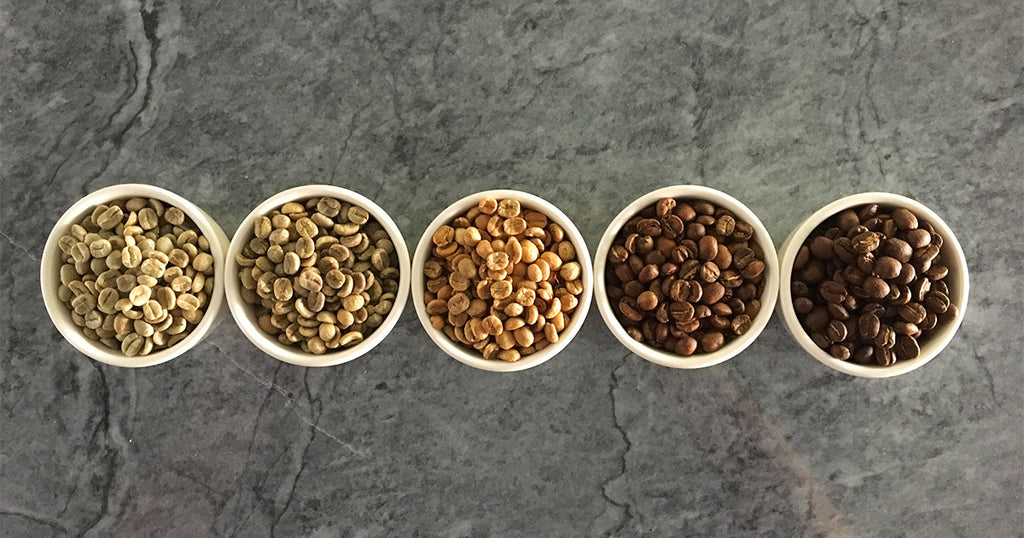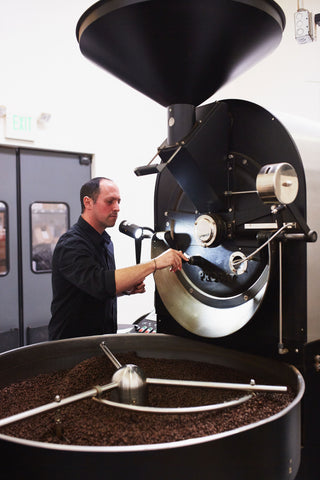
Roasting is one of the final steps our beans make in the long journey from the farm to your cup. In the capable hands of our Master Roasters, we seek to celebrate the classic characteristics unique to the country in which our coffees are grown to bring out their depth and complexity. Our roasters take years to learn this craft so they can elevate our coffees to their greatest potential.
Consider our much loved Casetta Blend – a silky combination of coffees from Costa Rica, Guatemala, and Ethiopia. The lushness of the jungle humidity, the crisp temperatures of high altitude, the arid heat of the desert – each of the three coffees in this blend has a distinct profile. And because it’s a drip coffee, we roast it on the lighter side of medium to balance and preserve its delicate notes. We want you to taste the fruit of these incredible places as you sip, which is why the knowledge, craftsmanship, and care of our roasters is paramount.
How We Roast - Science As Art
During the roasting process, we take our coffee from room temperature to somewhere between 400 – 430 degrees Fahrenheit. The art of roasting is determining the application of heat – how to get the coffee to the desired temperature, and in what amount of time. This decision is called a profile, and each of our coffees has their own.
A coffee’s origin, processing, altitude, moisture content, and many other factors like whether it’s being used for espresso or drip brew all factor into how a roaster decides to profile it. It’s a legitimately complex process. But we love to obsess over these details because being attentive to each element is literally what makes our coffee sing.
The following is by no means a comprehensive exploration of roasting but gives a general overview of our process.
Color As Cue
One of the primary cues a roaster will use is how the coffee bean changes color. Prior to roasting, coffee beans are generally green in color. Shortly after the coffee is put into the roaster, it starts to change color, turning from green to yellow to tan, and eventually to dark brown. The primary driver of this color change is the Maillard Reaction, which is a chemical reaction responsible for most of the browning you see in foods – steak, bread, french fries, and even toasted marshmallows. Our roasters use these color changes to know how quickly (or slowly) the coffee is roasting, and when to remove the beans from the roasting machine.

Forged In The Fire
The coffee bean itself goes through many structural changes during roasting. Due to the intense, controlled application of heat, coffee loses most of its moisture, leading to a roughly 15% reduction in mass. But while the weight decreases, the volume significantly increases, usually doubling the bean in size. At the beginning of a roast, the bean is endothermic, meaning it absorbs heat. Once the coffee gets to an internal temperature of about 400 degrees Fahrenheit, it becomes exothermic, giving off heat. At this stage the coffee will make audible popping sounds, something we call the “first crack”. This process is similar to how popcorn reacts to heat – absorbing as much as it can until it explodes. While only lasting for 30 – 45 seconds, “first crack” is a big moment during the roasting process, because it’s after this point that the coffee’s flavors, aromas, body, and acidity really start to develop.
Flavor, Sweetness & Acidity
Each coffee has its own distinct flavors – think jasmine, blueberry, butterscotch, dark chocolate – and some are naturally sweeter than others depending on the bean’s natural sugar and carbohydrate make up. These sugars break down during the roasting process, developing into caramel and fruity aromas. When we talk about acidity in coffee, we’re talking about the perceived experience (bright, effervescent, sparkling, etc), and not the actual pH level. Acids occur naturally in coffee, and each can provide an array of flavors that you’ve likely tasted in other foods. Coffees are at their most acidic right after “first crack”, and become less acidic the longer the roasting process goes on.
The Scentual Cup
Coffee aromas come from the development of volatile aromatic compounds inside the beans. Volatile aromatics evaporate at low temperatures and become trapped inside unground coffee. This is why a coffee’s aroma is the most intense right after grinding and also why we recommend never pre-grinding your coffee. There are over 800 volatile aromatic compounds in coffee (for perspective, wine has roughly 200) which appear in varying concentrations. These compounds peak in development shortly after “first crack”, after which they slowly dissipate, just like acidity.
The Great Debate
Light, Medium or Dark? On one extreme end, very lightly roasted coffee is considered underdeveloped, characterized by high acidity, a light body, and grassy, overpowering flavors. On the other end, very dark roasted coffees are considered overdeveloped, characterized by a lack of sweetness and acidity, burnt and bitter notes, and a blurring of flavors.
The roasting process itself begins to impart “roasty” flavors after “first crack”, which at their onset are very pleasant, but become unpalatable the longer the coffee is roasted. This is similar to grilling steak – the rarer the steak, the more intensely you can taste the meat. The more well done, the more it tastes like the grill. The art of roasting is about finding the balance between these two extremes.

Explore Our Premium Coffees



























